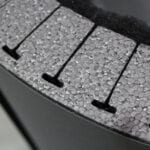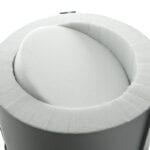Day in and day out, EnbiTherm significantly contributes to improving global energy efficiency and making a positive impact worldwide. With over 75 years of expertise, Enbi has developed insulation solutions that enhance the performance and efficiency of technical equipment across industries.
EnbiTherm is a range of flexible insulation materials designed to meet the growing demand for reliable and environmentally friendly options, suitable for both HVAC and solar applications.
Available in custom shapes and profiles, EnbiTherm allows simple installation by equipment manufacturers around the globe.
As we strive towards a more sustainable future, there’s an increasing emphasis on energy efficiency in our homes and businesses. A critical component of this efficiency is thermal insulation, particularly within HVAC and solar applications. Insulation materials have a vital role in maintaining comfortable indoor temperatures, ensuring HVAC systems work less strenuously and more economically.
Thermal insulation is now playing an important role in renewable energy technologies, especially solar applications. The integration of these materials can significantly reduce energy consumption and lower carbon footprints. This article will delve into the different types of insulating materials, their role in HVAC systems, their integration in renewable energy technologies, and the cost and environmental benefits associated with them. Understanding thermal insulation’s role can guide us towards more energy-efficient, cost-effective, and environmentally-friendly choices.
Understanding the Importance of Energy Efficiency
You’re probably wondering why energy efficiency is such a big deal, right? Well, not only does it save you money on your bills, but it also plays a crucial role in reducing our global carbon footprint. We can’t ignore the fact that our energy consumption directly impacts the environment. Every time we use an HVAC system or solar applications without efficient thermal insulation, we’re using more energy than necessary.
This excess energy usage leads to an increase in greenhouse gas emissions, contributing to climate change. Moreover, inefficient energy use can lead to higher energy costs, placing an unnecessary financial burden on households and businesses. Hence, energy efficiency isn’t just about saving money; it’s about safeguarding our planet and our economy too.
Thermal insulation is used extensively in many of our products including:
Role in Heating, Ventilation and Air Conditioning Systems
In the realm of heating, ventilation, and air conditioning systems, the right insulating material can be a game-changer, significantly reducing energy costs and enhancing indoor comfort. Thermal insulation in HVAC systems minimizes heat transfer, keeping warm air in during the winter and out during the summer. This results in less energy consumption, as the HVAC system does not have to work as hard to maintain a comfortable temperature.
Thermal insulation can also reduce noise pollution, a key aspect in the comfort of indoor environments. For solar applications, insulation is essential in maintaining the efficiency of solar thermal systems. It prevents heat loss, ensuring the collected solar energy is used to its maximum potential. Therefore, the role of thermal insulation is crucial for both HVAC and solar applications.
Integration in Renewable Energy Technologies
Harnessing the power of renewable energy technologies, your home can become a self-sufficient powerhouse, with every gust of wind or ray of sunlight being transformed into usable energy. The integration of thermal insulation in these technologies, particularly solar applications, enhances their efficiency.
For solar-thermal systems, insulation reduces heat loss from the collector and storage tank, maximizing the use of solar heat. Similarly, in photovoltaic systems, thermal insulation preserves the optimal operating temperature of solar panels, thereby increasing their power output.
Moreover, in HVAC systems powered by renewable energy, insulation reduces the load on the system, leading to lower energy consumption. This energy-saving attribute of thermal insulation not only minimizes the environmental footprint of households but also translates into significant cost savings. Thermal insulation, therefore, plays a crucial role in the successful integration of renewable energy technologies.
Cost and Environmental Benefits
While it’s certainly true that the upfront investment might seem steep, the long-term financial advantages and environmental impact of integrating these energy-efficient technologies can’t be overstated. Over time, thermal insulation for HVAC and solar applications significantly reduces energy consumption, leading to substantial cost savings on utility bills. This reduction translates directly to fewer greenhouse gas emissions, contributing to global efforts against climate change.
Additionally, many governments offer incentives and rebates to those who invest in such technologies, easing the initial financial burden. The materials used in thermal insulation are often recycled or recyclable, adding to their ecological benefits. In the long run, the financial and environmental benefits of adopting these te
Imagine the comfort and savings you could enjoy by choosing the right type of insulating material for your home or office. Insulating materials play a crucial role in energy efficiency, especially in HVAC and solar applications. The most common types include fiberglass, cellulose, mineral wool, polyurethane foam, and polystyrene.
Fiberglass, made from fine glass fibers, is widely used due to its fire and moisture resistance. Cellulose, composed of recycled paper, is eco-friendly and provides excellent acoustic and thermal systems insulation. Mineral wool, made from rock or slag, is highly resistant to heat and sound. Polyurethane foam offers high thermal resistance and is easy to apply. Polystyrene, a type of plastic, is commonly used for its exceptional insulation properties and durability.
- UR-foams 12-650 kg/m3
- Polyethylene, melamine resin, composite, synthetic EPDM and filter (15-80 ppi) foams
- Heavy layer (bitumen)
- Fleece (non-wovens)
- Self-adhesives
- Foils (PET, copper, fleece, aluminum)
- EPS
Enbi also has the capability to refine materials by laminating special foils and adhesives (for example, PUR-foils, PET, aluminum, copper, conductive coatings). Our material range is based on PUR foams and similar material groups such as:
- PUR-foam from 10 kg/m³ up to 650 kg/m³
- Polyester foam
- Polyether foam
- Polyethylene foam
- Microcellular foam
- Melamine resin foam
- EPDM neoprene rubber, CR-EPDM etc
- Non-woven
- Silicone-rubber
- Homogeneous polyurethanes
- From 45 Sh A up to 95 Sh A
- Low fogging / low emission
- FMVSS 302, UL94, DIN4102
- Temperature range -40 °C to 180 °C
- Oleo phobic and hydrophobic
- Acoustic test (alpha cabin, acoustic impedance)
- Customized product development and engineering support with 50+ years of experience.
How do you maintain and clean thermal insulation in HVAC and solar applications?
To maintain and clean thermal insulation in HVAC and solar applications, regular inspections are necessary to check for damage. Cleaning should be done with care, avoiding water or harsh chemicals that could compromise insulation effectiveness.
Are there any potential health risks associated with thermal insulation materials used in HVAC and solar applications?
Yes, there can be health risks associated with thermal insulation materials. Some may contain harmful substances like asbestos or synthetic mineral fibers, which can cause respiratory issues when inhaled over extended periods.
How does thermal insulation in HVAC and solar applications affect the operational noise level?
Thermal insulation in HVAC and solar applications can significantly reduce the operational noise level. It absorbs and minimizes sound vibrations, leading to a quieter operation and improved overall user experience.
What is the lifespan of thermal insulation used in HVAC and solar applications?
The lifespan of thermal insulation used in HVAC and solar applications can vary greatly. Factors such as installation quality, environmental conditions, and maintenance can influence the durability, often lasting between 15-30 years.
Are there any specific certifications or standards that thermal insulation for HVAC and solar applications must meet?
Yes, thermal insulation for HVAC and solar applications must meet specific standards. These include ASTM International standards, International Code Council (ICC) standards, and certifications like GREENGUARD for low emissions.
Get a Quotation
Please tell us more about your thermal insulation needs.
Download our insulation brochure

Find your local Enbi facility to enquire about our Thermal Insulation.

Urgent technical question? Contact our experienced engineers for advice.




